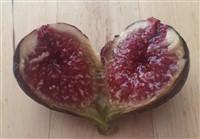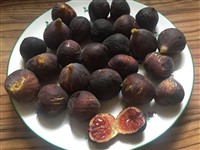| Hardy Chicago |

According to some sources, this variety was found in the early 1980's on the southside of Chicago where it grew without any protection, but its origins are believed to be on Mount Etna (Sicily). The place where it was discovered and the fact that Hardy Chicago is nowadays a widespread cultivar in North America demonstrates its capacity to survive in very cold climates.
Furthermore, the ability to ripen an early main crop indicates that it is a very well adapted fig tree for non-mediterranean climates. Hardy Chicago is a vigorous, but medium sized fig tree with a shrubby habit and a spreading crown, whose productivity seems to benefit from regular pruning. It bears theoretically two crops, but doesn't produce brebas every year. Generally, the brebas are scarce, small and of modest quality. However, the most interesting aspect of this variety resides in its early, large and quite good quality main crop. The first ripe fruits can be picked by the end of August and sometimes even earlier on August 20th in 2018 and 2019 in Vienna. Usually, the entire crop may be harvested. The main crop figs are rather on the small side (about 35 g, sometimes reaching 40 g). The fruits are rather sweet with light notes of honey and red fruits. The texture is pleasant, slightly jammy with a thin skin giving a rather pleasant sensation in the mouth. The figs are generally purplish-blue when fully ripe, sometimes showing coppery brown and greenish glints with an often cracked skin. Resistance to humidity is average, but since these figs ripen quite early, there is a better chance of avoiding the cool and rainy periods of autumn. As a conclusion, Hardy Chicago is a variety that is very well adapted to cold winters and short season climates. This cultivar has an extraordinary ability of wood lignification and an outstanding resistence to cold. It is an early bearer, very productive and has fruits of good quality. The breba crop is too seldomly harvested and is of poor quality. It would make sense to assiociate Hardy Chicago to a later two crop variety (Desert King, Negronne, Dalmatie) in order to have a more reliable (and better) breba crop and to extend the main crop season in autumn. |
| General data | |
| Origin | Italy, Sicily |
| Synonym(s), local names | Mongibello, Bensonhurst Purple |
| Tree type | Common |
| Crop | Uniferous |
| Tree morphological characteristics | |
| Shape | Erected |
| Vigor | Strong |
| Ability to produce suckers | Strong |
| Height after 10 years | 400 |
| Width after 10 years | 350 |
| Minimum width | 300 |
| Branch morphological characteristics | |
| Branch color | Brown grey |
| Caliber | Medium |
| Buds | Red |
| Leaves morphological characteristics | |
| Leaves | Average |
| Lobs | 5 |
| Depth | Medium sinuses |
| Adaptation outside the Mediterranean area | |
| Cold hardiness | Excellent |
| Wind resistant | Good |
| Pot culture | Good |
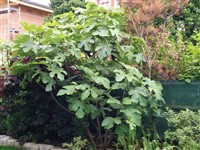
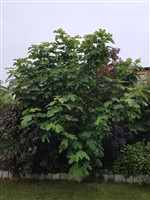
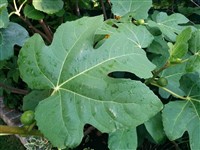
| Breba crop |
| Yield | Weak |
| Fruits dropping | Partial fruit drop |
| Alternance | Strong |
| Sensitivity to splitting | Medium resistant |
| Crop begin date (day-month) | Vienne:03-07 |
| External characteristics | |
| Skin color | Green, brown-violet |
| Skin thickness | Medium |
| Shape | Round |
| Stalk | Breaks off readily |
| Stalk shape | Short and medium |
| Neck | Medium |
| Neck color | Green |
| Eye | Small, closed |
| Eye color | Red |
| Average weight (grams) | 35 g |
| Internal characteristics | |
| Pulp color | Dark red |
| Seeds | Felt, medium |
| Organoleptic evaluation | |
| Texture | Pasty |
| Sugar | Little sugar |
| Taste | Medium |
| Perfume | Weak |
| Organoleptic descriptors | Fruity, Melon |
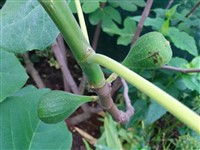
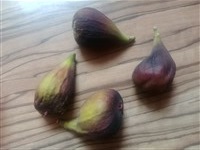
| Main crop |
| Yield | Strong |
| Fruits dropping | No fruit drop |
| Alternance | Medium |
| Sensitivity to splitting | Medium resistant |
| Crop begin date (day-month) | Vienne:20-08 |
| External characteristics | |
| Skin color | Violet |
| Skin thickness | Very thin |
| Shape | Round |
| Stalk | Breaks off readily |
| Stalk shape | Short and thick |
| Neck | Medium |
| Neck color | Green, sometimes pink reflections |
| Eye | Medium, closed |
| Eye color | Red |
| Average weight (grams) | 30 - 40 g |
| Internal characteristics | |
| Pulp color | Dark strawberry |
| Seeds | Felt, medium |
| Organoleptic evaluation | |
| Texture | Juicy |
| Sugar | Very sweet |
| Taste | Very good |
| Perfume | Medium |
| Organoleptic descriptors | Fruity, Red berries, Honey |



